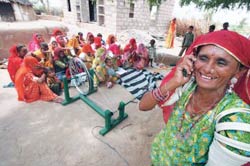Barmer's tryst with oil

In water-starved, sparsely populated Barmer, one of the five Rajasthan districts that fall in the Thar Desert, land would be the last thing to quarrel over, one would have thought. Control of land and what lies beneath it, however, seems to have become the cause celebre in the border district, much in line with the way industrialisation is forcing itself on to rural areas elsewhere in the country. That's happening even as industrial investments, especially following the discovery of oil and gas in Barmer, promises to transform the local economy, which has long suffered from the harshness of the desert.

- The Rajasthan government is acquiring 8,000 hectares in 30 villages of Barmer, close to NH-15, for a 1,080 MW power project based on lignite mining, which will reportedly displace 40,000 people. The project, for which mining will be jointly executed by Rajasthan State Mines and Minerals (RMML), a state government entity, and Sajjan Jindal’s JSW Energy, is facing opposition not just from the affected farmers but also from local BJP MP Manvendra Singh. The farmers have dragged RajWest Power, a Jindal subsidiary that will build the power plant, to Rajasthan High Court, alleging that the project does not address the issues of adverse environmental and social impact. In an area where it’s usual for women to walk a few kilometers to fetch water, 12 per cent of water from the Indira Gandhi Canal has been reserved for the power plant even as Barmer’s denizens still wait for their share.
- Last March, the Centre told Parliament that at least 48,000 acres of land in Barmer and Jaisalmer extending right up to the “Zero Line” (i.e. the sensitive Indo-Pak border) had been sold over the years to buyers from various parts of the country, mostly in benami transactions. Following the discovery of the “land grab”, involving thousands of crores of rupees, the state government cancelled the sale deeds and registered cases against 900 persons. It’s also probing why the buyers suddenly became interested in acquiring desert land near the border, which apparently has no profitable use.
- The District Administration is not ruling out protests over acquisition of land and right of use (RoU) by Cairn India, which is exploring and drilling for oil in Barmer basin. The company, which is also building a 590 km pipeline from Barmer to Salaya in Gujarat, has had a peaceful run so far.
Camels and Toyotas

Livelihoods are supplemented by animal husbandry, handicrafts, and men taking up any work that comes their way. Some of the local industries (in the small-scale sector) listed by the state government are Bentonite grinding, cement bricks, flour mills, granite cutting and polishing, and plaster of Paris.

Rainfall being deficient, Barmer relies on government water supply— tanks located along roads and fed with piped water—and tankas (rainwater harvesting structures built for an individual family or one or more dhanis), which still entail an onerous effort for women to carry water home. Electricity has not reached most of these villages.
The economy of Barmer town, on the other hand, seems to be thriving, thanks not only to the spin-offs from the fledgling of oil and gas industry, but also due to sustained efforts to leverage local strengths in handicrafts and animal husbandry.

“Three years ago, there used to be just one hotel in Barmer town. Today there are 6-7 hotels with high occupancy,” says a spokesperson for Cairn India, which expects its Mangla fields in Barmer to start yielding oil by the next year. Ravi Jain, District Collector of Barmer, says that the big industries have been instrumental in the growth of services like tourism, hotels, transportation and communication in the district.
Learn they must
As industrial capital exerts its influence over the age-old economy of Barmer, the locals are learning new skills and brushing up on old ones. Cairn India, for example, has set up an Enterprise Centre in collaboration with International Finance Corporation (IFC) and International Centre for Entrepreneur and Career Development (ICECD, the NGO implementer), training local youth in masonry, fabrication, carpentry, electricals, plumbing, and even repairing of mobile phones and automobiles. The primary objective of the initiative is to help the project-affected families (families that have lost their land) improve their employability.

At the office of Rawlinadi Milk Cooperative, which also acts as a milk collection centre, with a solar battery charged-computer and a machine to measure milk fat, Govardhan Ram, a member, says: “The cooperative enables us to conveniently get the feed and medicine for our cattle. Payments are better and timely too.”

Ashok Sharda, a larger trader in handloom home linen, says his weekly payments to artisan-suppliers in Barmer have been over Rs 1 lakh. Fabindia, the Delhibased retailer, also sources over Rs 15-20 lakh worth of handicrafts every month from Barmer, which it’s trying to increase, says D.K. Sharma of Desert Artisans-Jodhpur, Fabindia’s sourcing arm in the area.
A tale of two worlds

For now, Barmer represents a place split into two worlds—there are modern industries that seek to master nature to create enormous wealth and there’s a traditional economy that has submitted to nature for centuries. The locals need to wise up fast to the developments that can fundamentally transform their lives.










